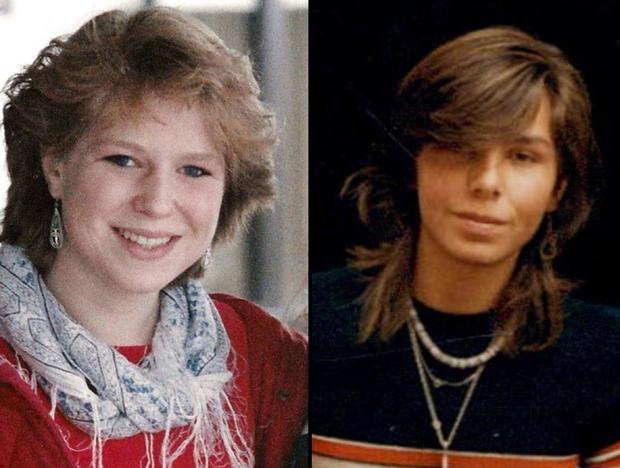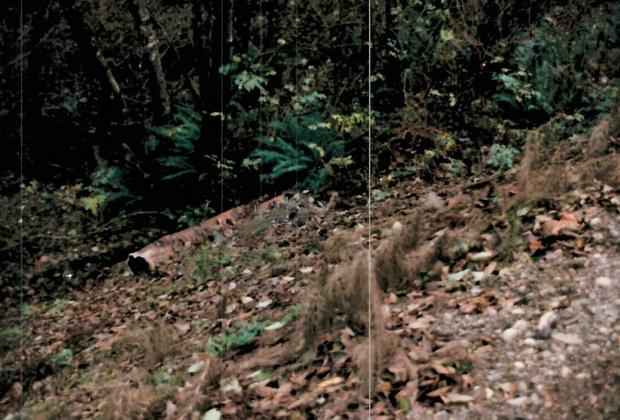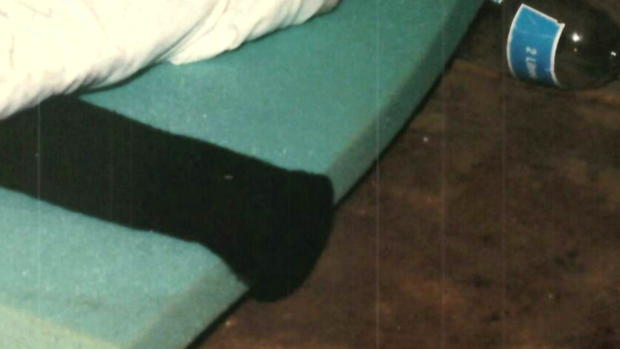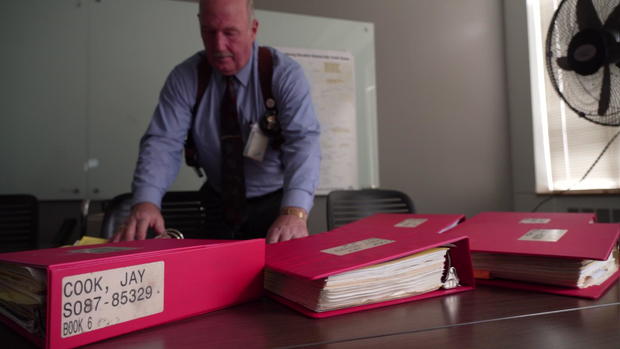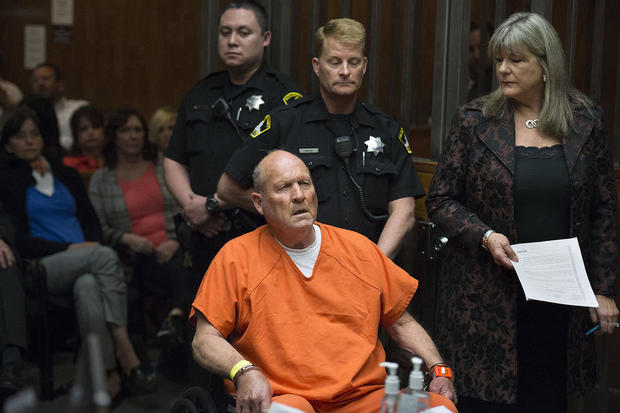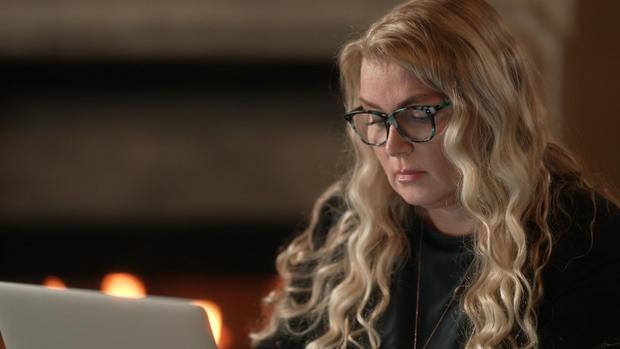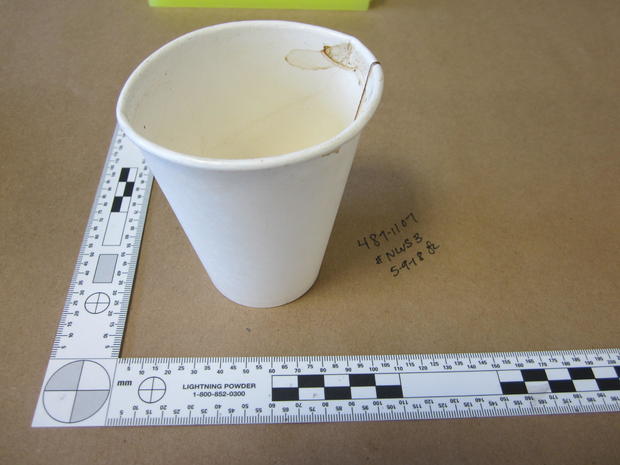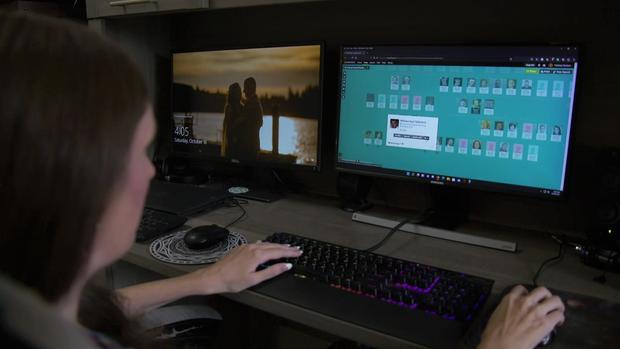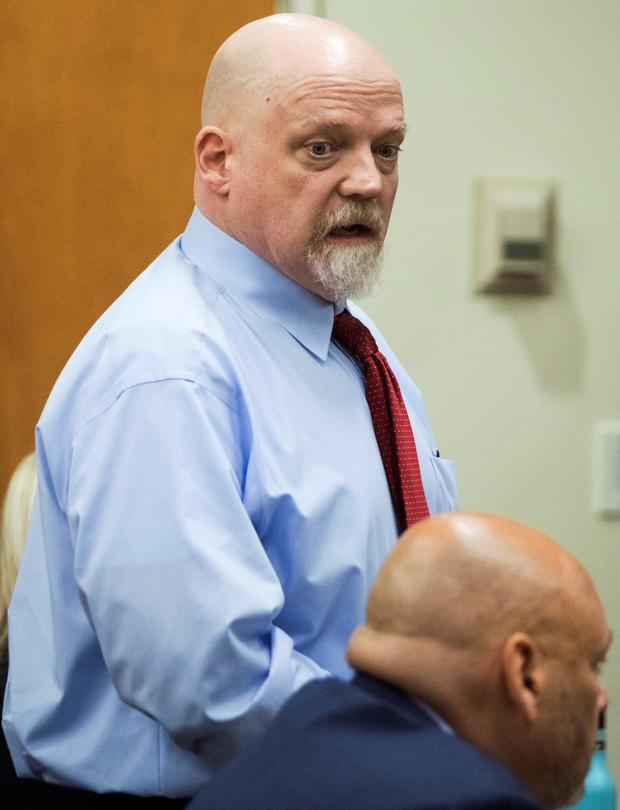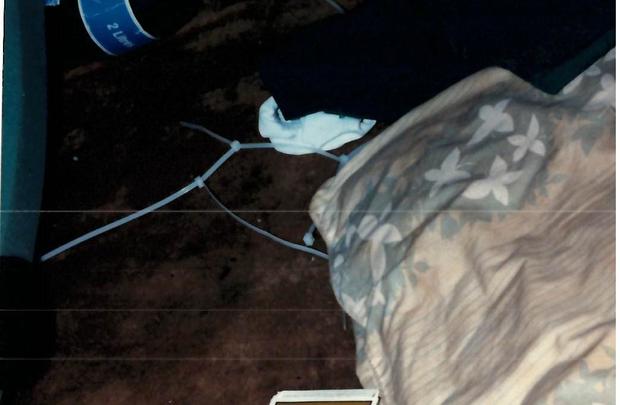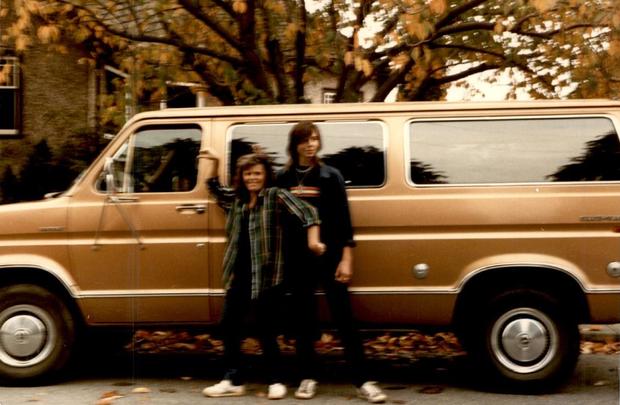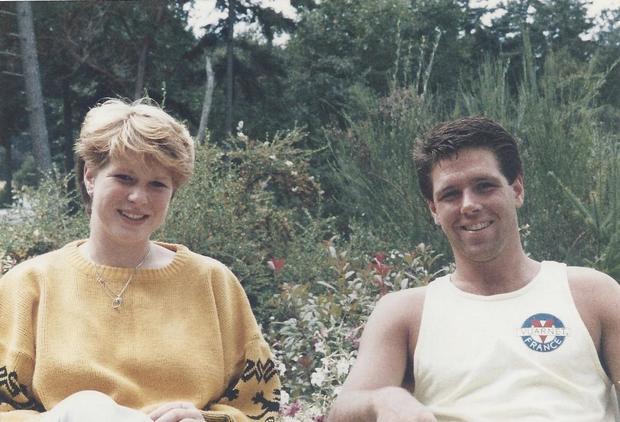When Chelsea Rustad uploaded her DNA on a public database, she never expected two police investigators would appear on her doorstep.
“They let me know that they are investigating a family member of mine for murder,” she tells “48 Hours” correspondent Erin Moriarty. “… a double homicide from 1987 … This was a person who was in my family tree.”
For more than 30 years, investigators in Washington state had been trying to solve the murders of 18-year-old Tanya Van Cuylenborg and her 20-year-old boyfriend, Jay Cook.
The killer’s identity remained a mystery for investigators until DNA evidence found on Tanya’s pants was uploaded to the same website that contained Rustad’s DNA, enablng genetic genealogist CeCe Moore to identify the likely suspect in just two hours.
Moore, known for her work on the PBS series “Finding Your Roots,” was called in to help find the person who matched the unidentified DNA.
“It’s the web of matches,” Moore says. “It’s putting those pieces together little by little.”
“Genetic genealogy has exposed a lot of secrets that people had hoped would remain secret,” Moriarty says to Moore.
“Yes,” Moore says. “Oftentimes, it’s someone’s deepest, darkest secret.”
How did Moore narrow down the suspect? And how did he elude investigators so long?
YOUNG COUPLE MURDERED
Det. Jim Scharf: I have a problem that I’m relentless and I don’t give up (laughs).
There may be no more dogged investigator than Snohomish County cold case detective Jim Scharf. Especially when it came to the murders of Tanya Van Cuylenborg and Jay Cook.
Det. Jim Scharf: It was probably the most horrendous unsolved case that we had. … Tanya Van Cuylenborg was an 18-year-old girl. She’d just graduated from high school. She was in a new relationship with Jay Cook.
On November 18, 1987, the young couple left British Columbia in Jay’s parent’s van heading for Seattle, Washington.
Det. Jim Scharf (with map): Jay was going to go to GENSCO Heating in Seattle to pick up some furnace parts for his dad.
They planned to sleep in the van, near the store, and drive back to Canada the next day.
Det. Jim Scharf: So, when they didn’t show up that evening, the families became concerned.
John Van Cuylenborg: We just had no idea where they might be or what might have transpired.
Tanya’s big brother John was at college when he got a call from his worried father.
Erin Moriarty: John, would your sister ever just go off and not call your parents?
John Van Cuylenborg: No. I don’t think that it ever happened … you know, if the plans had changed and she was going to spend another night … she would have called my parents.
After Tanya and Jay were reported missing, law enforcement began looking for them. Desperate for answers, John and his father joined the search in Seattle.
John Van Cuylenborg: Something was gravely wrong. I mean, the obvious things in terms of them being in hospital or something or just simply with a flat tire somewhere, all those more innocent explanations were pretty much vanishing.
On November 24, six days after the couple disappeared, John’s worst fears were confirmed. Tanya’s body was found at the bottom of ditch in rural Skagit County, some 80 miles north of Seattle.
Det. Jim Scharf: She wasn’t wearing any pants or panties. … and her bra was pushed up over her breasts. So, it obviously looked like a rape-murder.
Tanya had been shot in the head at close range.
Det. Jim Scharf: She rolled down the hill … It was a quick execution.
Later that evening, John had to identify his sister’s body.
John Van Cuylenborg: It’s such a crushing feeling … that all of a sudden you see her lying there. … It’s definitely horrific. … But we had no idea still about where was Jay? Where was the van? … How did this happen? Why did it happen?
The next day, Tanya’s wallet, the keys to the van, some bullets, and a number of other items turned up 16 miles away, in Bellingham. They had been discarded under the porch of a local tavern next to the Greyhound bus station.
Police located the van in a nearby parking lot, but Jay was still missing.
Det. Jim Scharf (showing map): The following day … Jay’s body was found … underneath High Bridge.
He was about 70 miles south of where Tanya had been found.
Det. Jim Scharf: It was a horrible scene.
Her 20-year-old boyfriend had been strangled — a pack of cigarettes stuffed down his throat.
Erin Moriarty: What did most investigators think about this killer? I mean, who does something like this?
Det. Jim Scharf: Right. That was the big question. … this was a person who was a real predator. And it was … believed at the time … that it was probably a serial killer or an ex-convict.
But finding that predator would be challenging. Investigators and forensic scientists had four crime scenes scattered over three counties, but few clues. A bullet casing found on the hillside near Tanya’s body matched those bullets collected at the tavern in Bellingham, but a gun was never found.
A surgical glove was discovered under the porch. Investigators believe the killer wore it to avoid leaving fingerprints. But he may have been careless.
Det. Jim Scharf: There was a palm print on the back of the van that … they believed hopefully belonged to the suspect.
Inside the van, they found what would ultimately be the most important piece of evidence: the black pants Tanya had been wearing.
Det. Jim Scharf: They found that there was semen on Tanya’s pants … and when they examined the semen, they learned that it couldn’t be left from Jay.
The sample matched the DNA found inside Tanya’s body, and would later be known as “Individual A.”
But the only evidence that connected all four crime scenes were plastic zip ties found near Tanya and Jay’s bodies, under the porch, and inside the van. According to Detective Scharf, they were part of the killer’s rape-murder kit.
Det. Jim Scharf: This was a predator that was hunting for a victim that he wanted to rape. And maybe in his mind, he decided that he was going to kill them too.
John Van Cuylenborg: They were two-mild mannered, soft-spoken kids. They weren’t out to pick a fight with anyone. … I mean, both families were just so devastated.
Hoping to find the killer, Tanya’s family offered a $50,000 reward for information. Tips came in, but none panned out.
John Van Cuylenborg: The police, to their credit, were trying to chase down every sort of theory.
Over the years, the theories and false leads would grow, and more than 200 names would fill the case file; some were convicted felons. And then there was Charles Sinclair.
Det. Jim Scharf: He was believed to be a serial killer across the western United States.
There also was an anonymous writer who sent threatening letters to Jay and Tanya’s families claiming to be the killer.
John Van Cuylenborg: It was just unfathomable to think that, you know, somebody not only had done these murders but then was going to continue taunting the families with these letters.
But every suspect’s DNA was compared to Individual A’s profile, and none matched.
Lisa Collins: the goal was to try to figure out … Who did this semen sample belong to?
Lisa Collins, a forensic scientist with the Washington State Patrol, uploaded Individual A’s profile to CODIS – the FBI’s national offender database.
Lisa Collins: As the years went by, just complete silence. … it’s disheartening. You just — are afraid that this might be one of those cases that’s never gonna be solved.
And then, more than 30 years after Tanya and Jay were killed — there’s a break in the case.
Lisa Collins: I was skeptical. I was hopeful but I was skeptical. And I– I’m a believer now.
AN INVESTIGATIVE GAME CHANGER
Lisa Collins: We had those original semen samples — from the pants and then from Tanya’s body … trying to figure out who this sample may belong to … that was the tedious and hard part.
The man police believed killed Tanya Van Cuylenborg and Jay Cook left behind a forensic calling card, says Lisa Collins, but still managed to elude capture for years.
And then in 2017, Detective Jim Scharf heard about an innovative tool developed by Parabon NanoLabs that uses DNA evidence to predict the genetic traits of an unknown suspect. It’s called Snapshot Phenotyping.
Det. Jim Scharf: They gather all that information, and they end up making a Snapshot … of what an individual with all of those traits might look similar to.
Parabon was hired to use Individual A’s DNA to create a composite sketch which gave Scharf some clues as to what the suspect could look like at the ages of 25, 45 and 65, but he still didn’t have a name.
Then, in 2018, a stunning arrest in California opened new doors for law enforcement.
GAYLE KING | “CBS THIS MORNING”: Investigators in California say DNA evidence led them to one of the country’s most notorious serial killers. …He is believed to be the so-called Golden State Killer.
The man responsible for numerous rapes and murders was finally apprehended after 43 years using genetic genealogy.
Erin Moriarty: Did a little light bulb go over your head at that moment?
Det. Jim Scharf: Oh yeah, big light bulb.
The Golden State Killer’s DNA had been uploaded to GEDmatch, a genetic database that allows users of various consumer test kits to share and compare their DNA.
Det. Jim Scharf: This is fantastic. I need to get on this.
Parabon agreed to upload Individual A’s DNA to GEDmatch and called in genetic genealogist CeCe Moore. She’s known for her work on the PBS show, “Finding Your Roots.”
And she’s famed for skills at mapping family trees. But this was her first criminal case.
CeCe Moore: I had had a lot of doubts whether this was the right thing for me to do and I finally made the decision, “OK, I’m — I’m gonna do this.” But a lot was riding on that case.
It was a case she had been following for years and felt a personal connection to. Moore’s parents were from the Pacific Northwest, and she was the same age as Tanya Van Cuylenborg.
CeCe Moore: She was killed right when I was graduating high school, and going onto college, and my life was just really beginning and hers ended so tragically. And so, I think it always stuck with me.
On Friday April 27, 2018, Individual A’s DNA file was uploaded to GEDmatch.
CeCe Moore: It’s compared against everyone that’s participating in that database. And so, what they’re looking for are long segments of identical DNA between two people. … Sometimes the match list will show up right away and sometimes it takes a couple of days. So, I stayed up really late that Friday night. I kept checking. There were no matches.
The next morning Moore logged on to see if there was a list.
CeCe Moore: And there was. … And so, we’re hoping for at least a second cousin or closer at the top of that list. … And we used to call that bein’ struck by lightning.
Erin Moriarty: Were you struck by lightning in this case?
CeCe Moore: Twice. We were stuck — struck by (laughs) lightning twice.
On the list were two people who shared enough DNA with Individual A to be his second cousins.
Erin Moriarty: And what was that — what was that feeling like?
CeCe Moore: It was pretty exciting (laughs) and s — scary.
In this case the cousins shared DNA with Individual A but not with each other, which meant they’re related to him on different branches of his family tree. But to figure out who he was, Moore first had to find out who they were.
CeCe Moore: Now, fortunately one of the people at the top of that list had a really unique name.
Erin Moriarty: And what was her name?
CeCe Moore: Chelsea Rustad.
Chelsea Rustad had taken an Ancestry DNA test and then went a step further.
Chelsea Rustad: You can download your raw DNA file to your computer and then upload it to GEDmatch. … I just had no inkling at all that … that there were secret relatives I didn’t know about or mysteries to uncover.
Neither did the other second cousin – who Moore was also able to identify – but has chosen to remain anonymous
CeCe Moore: And then I built the family trees of those top two matches, and surprisingly quickly I discovered how they converged. … it only took me two hours to come to the identification of who I believed to be Tanya and Jay’s killer.
Erin Moriarty: This is a person who had eluded capture, investigation for 31 years, and you were able to identify this person in two hours?
CeCe Moore: That’s the power of genetic genealogy. Yeah.
Erin Moriarty: But how sure were you?
CeCe Moore: I was very sure.
Erin Moriarty: But isn’t that scary, CeCe? Because … your work might end up with this person in prison.
CeCe Moore: Right. And at that moment I’m the only person in the world who knows that he’s probably guilty of this crime, other than him, of course. And so, it is a super heavy burden.
Monday morning, April 30, Detective Jim Scharf got the news.
Det. Jim Scharf: We’ve got it narrowed down to one guy. And I’m thinking I don’t believe this
… And my first thought is … who’s the guy?
A SUSPECT IS IDENTIFIED
Thirty-plus years. Dozens of dead ends. Hundreds of false leads.
And then, in April of 2018, CeCe Moore got on a computer and out of the billions of people on earth, identified — through genetic genealogy — the one man she believed killed Jay Cook and Tanya Van Cuylenberg.
Erin Moriarty: Who was the person you identified?
CeCe Moore: William Earl Talbott II.
William Earl Talbott II. When Detective Jim Scharf heard the name, he ran it through the system and was surprised to learn that Talbott had no felony convictions.
Det. Jim Scharf: It was a new name we’d never heard of before. … But it was sure nice when we found out that he only lived 7 miles from the bridge where Jay’s body was found.
Scharf also learned that in 1987, Talbott, who was 24 at the time, worked as a delivery driver and made stops near where Jay and Tanya were headed to pick up that furnace part — and says Talbott was fired a few months before the murders.
Det. Jim Scharf: So, it makes sense … that he was down in that area prowling around and probably ran into Jay and Tanya.
But Scharf needed more than old work records and genetic genealogy.
CeCe Moore: It’s really just a tip. It’s an investigative lead.
To make an arrest, Scharf needed to be sure that the DNA left at the crime scene by the man they knew only as Individual A matched William Talbott’s. So somehow, Scharf had to obtain a fresh DNA sample from Talbott himself.
Det. Jim Scharf: We were going to follow him until he dropped or threw away anything that had touched his mouth because we wanted his saliva on it as the best type of DNA source.
Investigators learned Talbott now drove a semi, and they began tailing his truck. One day about a week later, they watched as Talbot stopped at a red light and opened the truck door.
Det. Jim Scharf: The light changes to green, he slams the door and drives away, and there’s a white paper cup laying on the street. … It’s blowing around in the wind. So, they jump out, they go over and they collect the cup, and they call me.
Scharf rushed the paper cup to forensic scientist Lisa Collins with the Washington State Patrol.
Lisa Collins: They wanted me to test this cup and just see if I could get a DNA profile from it.
Scharf left the cup at the lab to await the results. CeCe Moore had already begun searching for Talbott online, and quickly found his sisters and father on social media.
CeCe Moore: I couldn’t find hardly anything about him. You know, no marriages. I could find very little footprint online at all. And that was a little unusual.
Years earlier, someone else who knew nothing about the investigation, had made a similar search … Chelsea Rustad. In 2013, long before she submitted her DNA to any websites, Rustad Googled her grandpa’s sister Blanche and found a lot of information online.
Chelsea Rustad: Her daughter was Patty Talbot. And Patty had three daughters and one son, and the son was William Earl Talbott.
These were Rustad’s second cousins, the Talbotts. Chelsea friended two of the sisters on Facebook, but their brother William was a mystery.
Chelsea Rustad: This guy was just kind of a question mark. Off the grid.
Rustad figured William Talbott was estranged from his family, but didn’t give it much thought, even after she uploaded her DNA to Ancestry.com and then GEDmatch. So, she was stunned that day in 2018, when those investigators showed up on her doorstep, and asked to see her research.
Chelsea Rustad: Man, I’m just kind of like, “wait. One of — you’re saying one of my family members is connected to a murder?” And they’re saying, you know,” yeah. It’s from 1987. And the person of interest is William Earl Talbott.”
Chelsea Rustad: And I’m like, kind of grasping the scope of this. … And … you know, sickened thinking about it.
The investigators wanted to know her impression of William Talbott.
Chelsea Rustad: I told them … my theory. That I think he’s estranged.
Detective Scharf got more details from Talbott’s friends and family.
Det. Jim Scharf: He had a history of anger and violence when he was younger.
In audiotaped interviews with Talbott’s sisters, Scharf learned William’s troubles began when he was 11 and his father was seriously hurt in a motorcycle accident. The sisters say William began to lash out.
TALBOTT’S SISTER: He was really an angry kid.
TALBOTT’S SISTER: He beat me up, broke my tailbone, I had to go to the hospital.
Another sister says William hurt her too. Still, she said, she didn’t think he was capable of murder.
TALBOTT’S OTHER SISTER: Yeah, he … could be a bonehead, but not to the point of … attacking or killing somebody, no.
But would the DNA on the paper cup tell a different story? That was on Detective Scharf’s mind when he returned to the police lab, and Lisa Collins shared the results of her testing.
Lisa Collins: I said, “The profile from the cup matches Individual A.”… it was just an — an amazing moment, yeah.
Erin Moriarty: What did that feel like, Jim?
Det. Jim Scharf: I got tears in my eyes … I’m like, I can’t believe it. It’s so emotional. And then I’m like, yeah, we got him (laughs).
So, on May 17, 2018, nearly 31 years after two carefree teenagers set out on a road trip and never returned, Detective Scharf arrested William Talbott.
John Van Cuylenborg: He says “John, we got him.”
Scharf called Tanya’s brother John right away, saying that at long last Individual A was in handcuffs.
John Van Cuylenborg: I mean, that’s when it really sent a chill down my spine. … It was pretty overwhelming to think that it had all culminated in that moment right there, 31 years later.
The next day, William Talbott was charged with Tanya’s murder. Charges for Jay’s murder soon followed. Jay’s sister spoke at a press conference.
LAURA BAANSTRA: It’s hard to put into words this feeling of relief, of joy, of — of great sorrow that this arrest brings.
Jay’s mom said the moment was bittersweet.
LEONA COOK: On one hand, we are close to closure, and on the other, we’re still at a loss and I don’t have my only son, Jay.
Detective Scharf told the group he was grateful for breakthroughs in DNA technology.
DET. JIM SCHARF: If it hadn’t been for genetic genealogy we wouldn’t be standing here today.
But would evidence obtained through genetic genealogy be allowed in court?
FIRST TEST IN COURT
More than three decades had passed since those dark November days in 1987 when Jay and Tanya were found murdered. Now, with William Talbott’s arrest, Tanya’s brother John Van Cuylenborg was finally able to face the man suspected of his sister’s murder.
Erin Moriarty: And what did you think the first time you saw him?
John Van Cuylenborg: Just reviled. I mean, it’s hard to control your emotions.
Talbott pleaded not guilty to two counts of aggravated murder and so in June of 2019 his trial began in the Snohomish County Superior Court.
CeCe Moore: It was the first case ever to go to a jury trial where the suspect had been identified through investigative genetic genealogy.
Although the Golden State Killer had been identified first, Talbott’s trial would be before his, and CeCe Moore was acutely aware of how much was riding on the outcome.
CeCe Moore: We didn’t know at that point how genetic genealogy was going to be treated in court because there was no precedence.
The prosecution was hoping to make it a nonissue.
Matthew Baldock: I was going to minimize the exposure by kind of downplaying the importance of the genetic genealogy, knowing full well, that was the part of the case that was perhaps most intriguing to people.
Chief criminal deputy Matthew Baldock was the lead prosecutor on Talbott’s case. He approached the defense with a proposal: they would stipulate to the jury that the DNA from Individual A had come from William Talbott as an agreed upon fact.
Matthew Baldock: Much to my surprise, they agreed.
It was a major victory for the prosecution. The use of genetic genealogy to locate a suspect would not be contested in court.
CeCe Moore: That was a huge relief … really it was the best possible outcome.
Erin Moriarty: So, you admit that that is William Talbott’s DNA. Am I correct?
Jon Scott: You’re correct. That was a stipulation.
Talbott’s attorneys Jon Scott and Rachel Forde would argue there is actually an innocent explanation for that DNA.
Rachel Forde: Every indication of the DNA found … from my client indicated consensual sex.
Yes, they admit that Talbott had sex with Tanya, but deny he raped or killed her, or Jay Cook. They point out that Tanya and Jay were missing for several days before their bodies were found, implying that the couple must have encountered their killer later on.
Erin Moriarty: Tell me what you think then happened to Tanya and Jay?
Rachel Forde: We don’t know what happened. … These kids were off to an adventure. Whether they went to a bar, a restaurant, some sort of club to meet people, I don’t know.
Talbott’s lawyers say it’s understandable that Talbott might not remember meeting Tanya or even where he was 30 years ago, but it’s significant, they say, that investigators were unable to link Talbott to the type of gun that killed Tanya, the pack of cigarettes, or the materials used to strangle Jay.
Erin Moriarty: So … William Talbott’s defense is basically that he had sex with Tanya and then somehow somebody else killed her?
Jon Scott: That’s not William Talbott’s defense. William Talbott’s defense is that there is insufficient evidence to prove him guilty beyond a reasonable doubt.
But prosecutors say they do have sufficient evidence: there’s Talbott’s DNA from Tanya’s body and her pants, the fact that he had lived just 7 miles from where Jay’s body was found, and the palm print on the van that police say was a match to Talbott. Then there are the zip ties — found at all four crime scenes.
Baldock says they prove the connection between Jay’s murder and Tanya’s, and the van.
Erin Moriarty: What do you believe the zip ties were used for?
Matthew Baldock: I believe that Mr. Talbott had Jay and Tanya in the van for some period of time after he abducted or kidnapped them. And I believe that he used the zip ties to restrain them.
As part of his investigation, Detective Scharf had hoped to obtain a usable DNA profile from any of the zip ties.
Det. Jim Scharf: There had been a mixture of DNA on one of the zip ties that was found in Jay’s van. And they weren’t able to discern who all the profiles belonged to.
But mid-trial, forensic scientist Lisa Collins realized she could run that mixture into a new software program to see if they could find a match—and, to her surprise, she did.
Lisa Collins: When I compared — William Talbott’s DNA profile to the mixture obtained from the zip tie that was found in the victim’s van — he was included as a possible contributor.
But because her discovery came during trial, prosecutors felt it was too late to present to the jury, fearing it would delay the trial. Talbott elected not to take the stand, and his lawyers were hopeful the jury would agree there was not enough evidence to prove him guilty.
In their closing arguments, the defense told the jury police were unreasonably focused on the DNA.
RACHEL FORDE: They never stopped to consider that perhaps the person who left the DNA was not the murderer.
Attorney Forde argued Det. Jim Scharf had tunnel vision.
Erin Moriarty: Is it at all possible that yes, that was William Talbott’s DNA … but he didn’t kill either one of them?
Matthew Baldock: Is that possible? … Sure. Is it reasonable? … No. … She was found without her pants or underwear. … So, just practically speaking is the claim that Mr. Talbott had consensual sex with her and then she got dressed and the person who ultimately killed her undressed her?
Baldock says the only reasonable theory is that Talbott had overpowered the couple with the plan of raping Tanya and then killed them both.
MATTHEW BALDOCK: He had zip ties. He had gloves. He had a firearm. He had ammunition.
After a two-week long trial, the jury began to deliberate. But they didn’t come back that first day. Or the second …
John Van Cuylenborg: You realize this is really going to be the moment of truth.
A NEW ERA
On that third day of deliberations, the families of Jay Cook and Tanya Van Cuylenborg finally got news: There was a verdict.
“We the jury find the defendant William Earl Talbott II guilty of the crime of murder.”
Guilty. William Talbott had been found guilty of the aggravated murder of Tanya Van Cuylenborg, and guilty of the aggravated murder of Jay Cook.
John Van Cuylenborg: Just to hear them — hear the foreman of the jury say guilty was … surreal.
CeCe Moore wasn’t in the courtroom, but she later saw video of Tanya’s brother John’s reaction.
CeCe Moore: It was as if I could see a physical burden lift off his shoulders. He had told me how he had carried this burden — for years. You know, he was the only sibling. He was her older brother … And so, you know, that was incredible to see.
Chelsea Rustad had never spoken to either Jay or Tanya’s family. But with their blessing, she decided to attend Talbott’s sentencing—where she first met John.
CHELSEA RUSTAD: John?
JOHN VAN CUYLENBORG: Chelsea?
CHELSEA RUSTAD: Pleasure to meet you.
JOHN VAN CUYLENBORG: Pleasure to meet you.
Chelsea Rustad: I was really nervous … you know, he looked a little bit nervous as well.
CHELSEA RUSTAD [hands John a bouquet]: I wanted to give this on behalf of the Rustad family.
JOHN VAN CUYLENBORG: Wow, that’s very thoughtful. Thank you for coming today.
John Van Cuylenborg: She’s, effectively, a family member of the murderer. … so, I think it was brave of her to take that risk.
At the sentencing, Jay Cook’s mother told the judge about the grief she has carried all these years.
LEONA COOK: Some of us wanted a shirt or a sweater. You wear them. You could put them to your nose and smell him. I still have that old sweater in my dresser drawer. Thank you.
The sentence was mandatory: two life terms in prison without parole.
JUDGE: The court’s only possible sentence for each count is to impose a sentence of life without the possibility of release.
Chelsea Rustad says her sympathy is for Jay and Tanya’s families, despite her genetic ties to Talbott.
Chelsea Rustad: His dad wasn’t there. His sisters weren’t there. He had a family member in the audience, and I was there supporting the victims.
Rustad is proud that her DNA helped bring a killer to justice, but there are some who have concerns about this new frontier in police work.
Andrea Roth: It might be that you’re not the Golden State Killer. But it also might be that you don’t want law enforcement scrutinizing your entire family.
Law professor Andrea Roth is head of the UC Berkeley Center for Law and Technology and says
one of the problems she sees is that the DNA used for genetic genealogy can be very revealing.
Andrea Roth: This is DNA testing that tells you a lot about a person’s very sensitive information, their medical history … information … about familial lines that the families themselves don’t even know.
Professor Roth does agree that in cases like this, genetic genealogy can be an effective tool for the public good. But she cautions that most states have no restrictions on its use.
Andrea Roth: There’s the concern that the government could use your DNA for some reason other than a criminal investigation that it shouldn’t be using it for: giving it to insurance companies or using DNA to find out who was at a protest meeting. … We don’t have evidence right now of the government doing that. But — those are — are reasons that somebody might want to think about before they decide to upload their DNA.
Because of this lack of legal oversight, Roth has deep reservations about sharing DNA on public genealogy websites.
Erin Moriarty: Would you not upload your DNA?
Andrea Roth: I would not.
But it may already be too late for Professor Roth or many other Americans to truly opt out.
Experts estimate that today more than 90 percent of white Americans can be identified using genetic genealogy, and that’s because, says CeCe Moore, those of European descent are well represented on websites like GEDmatch.
CeCe Moore: We have enough DNA. We can identify almost anyone of northwest European ancestry … even if it takes hours. Dozens of hours, hundreds of hours, we’ll get there.
But in this case, after more than 30 years with no solid leads, Moore was able to use Chelsea Rustad’s DNA to help locate a viable suspect in just two hours.
Erin Moriarty: Was this the fastest you’ve ever found a suspect?
CeCe Moore: It was. To this day, three and a half years later, hundreds of cases later, this was the most straightforward case I’ve ever worked. And that is amazing.
Detective Scharf believes this case changed the face of cold case investigations forever.
Det. Jim Scharf: Genetic genealogy is the best tool that’s come around since DNA … You don’t need a CODIS database … to get your match.
For Jay and Tanya’s families it means they finally have some answers and a measure of peace.
On Tanya’s grave, her parents inscribed the final line from a poem she wrote when she was 17: “There is a place that I know of … where up above there flies a dove … and slowly as it turns to dawn/she parts her wings and then she’s gone.“
John Van Cuylenborg: She was growing up and maturing and spreading her wings and getting her feet under her and then she was gone.
Erin Moriarty: You miss her still, don’t you?
John Van Cuylenborg: Yeah, definitely.
Produced by Lisa Freed, Sarah Prior and Mary Ann Rotondi. Lauren Clark is the field producer. Sara Ely Hulse and Charlotte Fuller are the development producers. Shaheen Tokhi and Addison Briley are the associate producers. Michael McHugh is the producer-editor. Atticus Brady and Michael Baluzy are the editors. Peter Schweitzer is the senior producer. Nancy Kramer is the executive story editor. Judy Tygard is the executive producer.
Download our Free App
For Breaking News & Analysis Download the Free CBS News app

